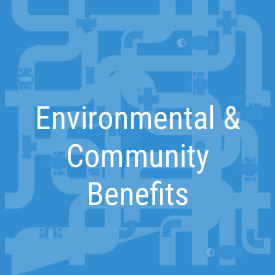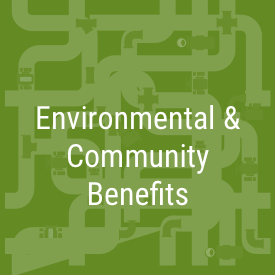This project is to enable Valley Water scientists to update custom software models of local creeks for the most current and accurate understanding of potential flood risks in high priority flood-prone areas and then develop options for managing those risks. Existing models will be verified, updated and recalibrated as conditions change. Updating our knowledge-base will lead to more effective creek management and maintenance. Valley Water will also convey this information to the community and partner cities.
When creek conditions necessitate rehabilitation to preserve flood protection, this project also funds preliminary engineering studies to isolate problem areas and explore potential solutions.
Under the 2012 Safe, Clean Water Program, Valley Water completed engineering studies on five (5) reaches of creeks as part of the Flood Risk Assessment Studies project. These were on Coyote Creek (Bay to Anderson Dam, including Rock Springs Neighborhood); Adobe and Barron creeks tidal flood protection (Highway 101 to Middlefield Road in Palo Alto); Alamitos Creek (upstream of Almaden Lake in San José); and Ross Creek (Guadalupe River to Blossom Hill Road in San José). The Coyote Creek study completed under this project was utilized to develop the short-term interim projects that Valley Water built to help reduce the risk of flooding along Coyote Creek (See Project E1 - Coyote Creek Flood Protection Project). These include the installation of an interim floodwall and embankment along the creek to protect the Rock Springs community from a flood event equivalent to the February 2017 flood. Valley Water also updated the Alamitos Creek 2-D hydraulic (HEC-RAS) model of the 1% (100-year event) floodplain and shared the information with the City of San José.
Revising flood models on a regular basis enables Valley Water to keep pace with changes in rainfall patterns and intensity as our climate changes. An up-to-date understanding of flood risks allows us to work toward preventing future flooding.








See Environmental & Community Benefits section for complete description of Key Performance Indicators (KPIs).
KPI #1: (engineering studies)
The South Babb Creek alternatives analysis was completed in FY22.
- The study incorporates refined hydraulic modeling and analyses to identify potential flood mitigation and 100-year flood protection projects on South Babb Creek for the area.
- The study explores the feasibility, constructability, and costs of the proposed alternative solutions.
- The engineering study on South Babb Creek has been leveraged for a capital project which is currently in design.
KPI #2: (floodplain maps)
Stevens Creek Floodplain Update
Goal: Develop updated 1D/2D HEC-RAS model for Stevens Creek, and use it to update the 100-year floodplain as well as some smaller-event floodplains which exceed the creek capacity.
The following progress has been made towards this goal:
- Developed an unsteady 1D HEC-RAS model of Stevens Creek, which will serve as the basis for a 1D/2D model for mapping out the floodplain.
- Substantial progress was made towards updating the hydrology for the Stevens Creek watershed, using new methodology developed by Valley Water. The approach leverages hydrology studies from similar watersheds which account for attenuation from pipes in the storm drain network. Once complete, the hydrology from this study will be used to update the Stevens Creek floodplain.
Canoas Creek Flooding Risk
Goal: Assess flooding risk for Canoas Creek and develop new floodplains as appropriate.
The following first steps towards this goal have been completed:
- A 1D steady state model was updated and calibrated to the 1/16/2019 high flow event, with peak flow of 894 cfs at Dow Drive (between a 2- and 5-year flow event).
Lower Penitencia Creek and Berryessa Floodplain Update
A hydrologic/hydraulic model was developed for Valley Water in 2018 with grant funding through the Federal Emergency Management Agency (FEMA) Cooperating Technical Partners Program. The model addresses the watershed area that drains to Lower Penitencia, Berryessa, Upper Penitencia Creeks and their tributaries. The model combines the hydrology and hydraulic calculations by routing rainfall over land and through an explicitly represented storm drain network, into the creeks, and back out onto the floodplain where spills occur.
Goal: Update the model to reflect as-built conditions of recently completed flood protection projects on Lower Penitencia and Berryessa Creeks, thereby meeting FEMA standards for a future Flood Insurance Rate Map update.
The following progress has been made towards this goal:
- Initiated model updates required to reflect the completed flood protection project.
- Data has been collected for the required updates.
April 2024
Preliminary 100 Year Floodplain Maps
Preliminary 10 Year Floodplain Maps
Documents
FY22-36 Key Performance Indicator for the Safe, Clean Water Program
-
Complete engineering studies on three (3) creek reaches to address 1% (100-year) flood risk.
-
Annually, update floodplain maps on a minimum of three (3) creek reaches in accordance with new FEMA standards.
Benefits
-
Provides more current and accurate mapping of areas at risk of flooding
-
Provides the technical basis for developing future flood protection plans, and for potential funding partnerships
-
Identifies, in a timely manner, the needs to prevent creek deterioration
-
Identifies the need for flood mitigation or creek rehabilitation projects
-
Facilitates communication with partner cities on evolving flood risks and possible solutions
-
Addresses climate change
Geographic Area of Benefit
Countywide
Engineering studies history and project background
Under the 2012 Safe, Clean Water Program, Valley Water completed engineering studies on five (5) reaches of creeks as part of the Flood Risk Assessment Studies project. These were on Coyote Creek (Bay to Anderson Dam, including Rock Springs Neighborhood); Adobe and Barron creeks tidal flood protection (Highway 101 to Middlefield Road in Palo Alto); Alamitos Creek (upstream of Almaden Lake in San José); and Ross Creek (Guadalupe River to Blossom Hill Road in San José). The Coyote Creek study completed under this project was utilized to develop the short-term interim projects that Valley Water built to help reduce the risk of flooding along Coyote Creek (See Project E1 - Coyote Creek Flood Protection Project). These include the installation of an interim floodwall and embankment along the creek to protect the Rock Springs community from a flood event equivalent to the February 2017 flood. Valley Water also updated the Alamitos Creek 2-D hydraulic (HEC-RAS) model of the 1% (100-year event) floodplain and shared the information with the City of San José.
About the Safe, Clean Water and Natural Flood Protection Program
In November 2020, voters in Santa Clara County overwhelmingly approved Measure S, a renewal of Valley Water’s Safe, Clean Water and Natural Flood Protection Program.
The program was first passed by voters in 2000 as the Clean, Safe Creeks and Natural Flood Protection Plan, then again in 2012 as the Safe, Clean Water and Natural Flood Protection Program. The renewal of the Safe, Clean Water Program will continue to provide approximately $47 million annually for local projects that deliver safe, clean water, natural flood protection, and environmental stewardship to all the communities we serve in Santa Clara County.
While evaluating ways to improve the 2012 program, Valley Water gathered feedback from more than 21,000 community members. That helped Valley Water create the six priorities for the renewed Safe, Clean Water Program, which are:
Priority A: Ensure a Safe, Reliable Water Supply
Priority B: Reduce Toxins, Hazards and Contaminants in our Waterways
Priority C: Protect our Water Supply and Dams from Earthquakes and Other Natural Disasters
Priority D: Restore Wildlife Habitat and Provide Open Space
Priority E: Provide Flood Protection to Homes, Businesses, Schools, Streets and Highways
Priority F: Support Public Health and Public Safety for Our Community
Each year, Valley Water prepares a report providing a progress update for each of these program priorities, along with fiscal year accomplishments.
To ensure transparency and accountability to the voters, the ballot measure also created an Independent Monitoring Committee, appointed by the Santa Clara Valley Water District Board of Directors. The Independent Monitoring Committee annually reviews the program’s progress to ensure the outcomes are achieved in a cost-efficient manner and reports its findings to the Board. Additionally, the IMC also reviews each proposed 5-year implementation plan prior to its submittal for Board approval.
In addition, the program requires three independent audits.


